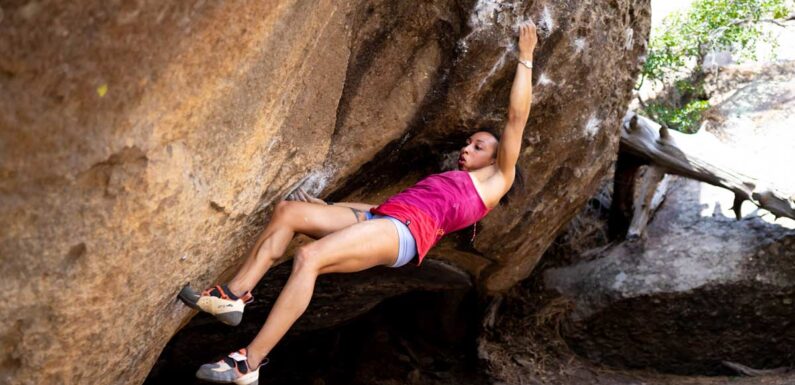
Although bouldering and rock climbing may initially appear identical, there are several noteworthy differences upon further comprehension. Both sports demand different strategies, training regimens, muscle group utilization, equipment requirements, etc.
Let’s find out the details of these two sports and how they differ.
Rock Climbing vs. Bouldering
What Is Bouldering?
Bouldering is rock climbing on small rock formations or artificial rock walls, typically without ropes or harnesses. Instead, climbers rely on crash pads to cushion their falls and spotters to help guide them safely to the ground. Bouldering focuses on short, intense routes that require precise movements and a high level of strength and technique.
Bouldering has become a popular sport in recent years due to its accessibility and the variety of challenges it offers. Unlike traditional rock climbing, bouldering can be done indoors in climbing gyms, making it possible to boulder year-around, regardless of the weather. This has also allowed the sport to grow and evolve, with climbers constantly pushing the limits of what is possible and creating new and more challenging routes.
In addition to its physical benefits, bouldering can also be a mentally challenging sport. Climbers must stay focused and think critically about each move, using their problem-solving skills to determine the best way to reach the top of the boulder. This can help build confidence, increase endurance, and improve mental toughness.
If you’re an experienced climber seeking a new challenge or just starting and looking for a fun way to stay active, bouldering has something to offer. With its combination of physical and mental demands, it’s no wonder that this fast-growing sport has become so popular.
What Is Rock Climbing?
Rock climbing is a sport that involves ascending natural rock formations or artificial rock walls using ropes, harnesses, and other protective gear. It requires physical strength, technique, and mental focus, making it a challenging and rewarding pursuit.
There are several styles of rock climbing, including traditional climbing, sport climbing, and free climbing. Traditional climbing involves placing protective gear into the rock as you climb and removing it on the way down. Sport climbing involves pre-placed bolts that offer protection as you climb, allowing for longer and more challenging routes. Free climbing involves ascending the rock using only your hands and feet, with the rope only used for fall protection.
Rock climbing can be done indoors and outdoors and offers a wide range of benefits, including improved cardiovascular fitness, increased strength, and better hand-eye coordination. It also helps build confidence and mental toughness, as climbers must overcome fear and stay focused on their goals.
In addition to its physical and mental benefits, rock climbing is also a social activity that allows climbers to connect with others who share their passion for the sport. Whether a novice or an expert climber, reaching new altitudes always presents a new challenge and a sense of success.
Overall, rock climbing is a sport that offers something for everyone, from the thrill-seeking adrenaline enthusiast to the physically fit and mentally focused athlete. Rock climbing is a sport worth exploring, whether you’re looking to push your limits, meet new people, or have a good time.
Differences Between Bouldering and Rock Climbing:
Bouldering and rock climbing are exciting and challenging, but some key differences are worth noting. Here are some of the essential differences between bouldering and rock climbing:
- Height: The height of the climb is one of the most apparent differences between bouldering and rock climbing. Bouldering routes are typically shorter, with climbers reaching heights of around 20 feet or less, while rock climbing routes can get hundreds of feet in height.
- Equipment: Bouldering is typically performed without ropes or harnesses, relying instead on crash pads to cushion falls and spotters to help guide the climber safely to the ground. On the other hand, rock climbing requires ropes, harnesses, and other protective gear to ensure the climber’s safety.
- Difficulty: Bouldering routes are often shorter and more intense, requiring precise movements and a high level of strength and technique. Rock climbing routes can be longer and more sustained, focusing on endurance, strength, and technique.
- Setting: Bouldering can be done indoors and outdoors, while rock climbing is typically an outdoor sport. This means that bouldering is more accessible and can be done year-round, regardless of the weather.
- Goals: Bouldering is frequently thought of as a technique to push the boundaries of what is feasible in a more condensed, intensive environment. On the other hand, rock climbing is often viewed as a way to test one’s endurance and mental toughness over a longer climb.
The Final Call:
Bouldering and rock climbing offer unique challenges and rewards, and the best choice depends on individual goals and preferences. Whether you prefer the intensity of bouldering or the endurance of rock climbing, both are excellent ways to build strength, increase fitness, and challenge yourself mentally and physically. You can start doing any of these activities as per your preference under the guidance of a grip trainer or a physical trainer.
